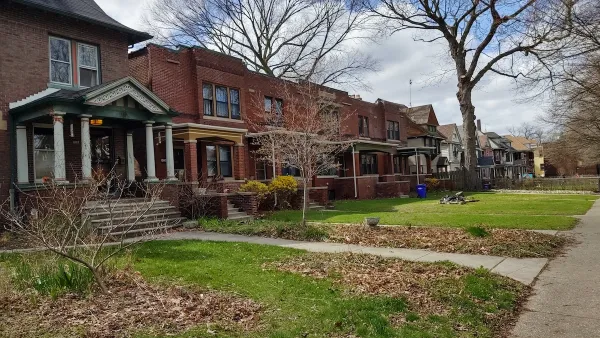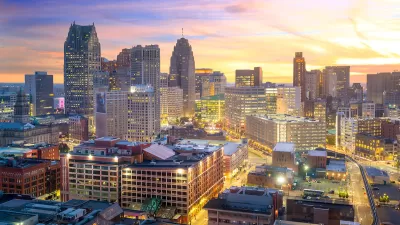Stories of Detroit’s nascent comeback often highlight the Rust Belt city’s attraction as a destination for America’s young hipsterati. Jay Walljasper explores the role that native Detroiters are playing in the city’s revival.
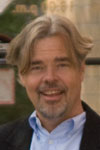 Sprinkled among gloom-and-doom stories coming out of Detroit is some unexpected good news: the city's growing appeal to young people. According to plentiful media reports, well-educated twenty-somethings are streaming into the Motor City to test out new ideas, explore art and music projects or launch D-I-Y revitalization initiatives.
Sprinkled among gloom-and-doom stories coming out of Detroit is some unexpected good news: the city's growing appeal to young people. According to plentiful media reports, well-educated twenty-somethings are streaming into the Motor City to test out new ideas, explore art and music projects or launch D-I-Y revitalization initiatives.
The real story is a bit more complex than that, but you can spot a number of once-dormant corners of the city now pulsing with activity thanks to young entrepreneurs. Corktown, in the shadow of the much-photographed ruin of Detroit's train station, sports pubs and restaurants that would fit in Brooklyn or Portland.
The Midtown district near Wayne State University and two major medical centers shows all the makings of a creative class hub, complete with hipsters hanging out at the Good Girls Go to Paris creperie, the Avalon International Breads bakery, and the N'Nmadi Center gallery, devoted to the rich tradition of African-American abstract art. Add in the venerable yet lively Detroit Institute of Arts, as well as handsome brick mansions still standing from the early 20th Century, and it's easy to understand Midtown's attraction.
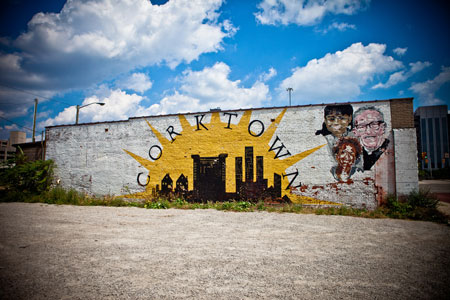
Recent college grads can be seen all over town, from the bountiful Eastern Market to bustling Campus Martius square to festive Mexicantown to the scenic Riverwalk to the yummy Good People Popcorn shop downtown, featuring flavors like cinnamon and chocolate drizzle.
This burst of youthful energy-even in the face of the city's continuing economic and social woes-debunks widespread opinion that nothing can be done to jumpstart the Motor City. While a new, more positive narrative about Detroit is welcome, there are problems in focusing entirely on idealistic young adventurers swooping in to save the city-it reinforces the stereotype of native Detroiters as hapless, helpless and hopeless.
The truth is, newcomers aren't the only ones stirring up excitement around town. Good People Popcorn, for instance, was started by two sisters and a cousin, all of whom grew up here. Sarida Scott Montgomery, one of the founders who is also a lawyer and Executive Director of the Community Development Advocates of Detroit, says people are often surprised she grew up in the city. "Not in the suburbs," she explains, "but in Detroit itself."
Regina Ann Campbell, manager of the Milwaukee Junction Small Business Center incubator in Detroit's North End, grew up on the Northwest side before earning a Masters in urban planning degree at the University of Michigan. "I welcome all the new people," she says. "But it's important for them to understand they are building on some things that have been going on for years. I want to help them appreciate the city though the eyes of the people who have lived here."
Scott Montgomery and Campbell are both part of a new initiative that matches the talents of bright, young professionals with local organizations working at the frontlines of reviving Detroit. The Detroit Revitalization Fellows Program (DRFP) selected 29 Fellows with backgrounds in urban planning, economic development, finance, real estate, and related fields out of 650 applicants from across the country.
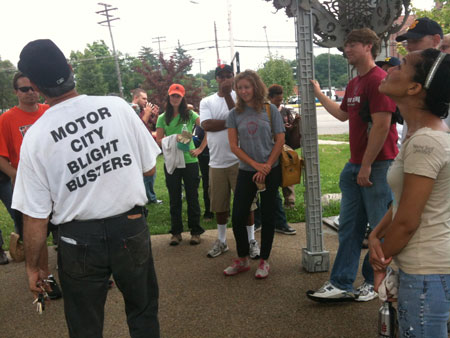
A lot of the buzz around the program highlights ambitious folks relocating from New York, Seattle, the Bay Area, Washington, D.C., Montreal, Chicago and Los Angeles to further their careers in Detroit, but in reality ten of the fellows were already living in Detroit and nine others had grown up in the metro area or previously lived in the city.
For many of them it was a long-awaited homecoming, which shows that continuing loyalty from the Detroit Diaspora is a hidden asset in the city's favor. Jela Ellefson, who was working at a Los Angeles urban planning firm before moving back with her husband, an architect, and two children, says, "We always followed what was happening in Detroit, and noticed that the urban planning world was paying a lot of attention. Life in Los Angeles was coming to feel very stressful in terms of time, distance and money."
The program-a Wayne State project financially supported by the Kresge Foundation, Ford Foundation, Hudson-Webber Foundation, Skillman Foundation and the university-placed fellows at organizations identified as being "actively engaged in building the Detroit of tomorrow." This covers everything from the Data Driven Detroit research firm to the Community Investment Support Fund, which directs investment capital to low-income neighborhoods.
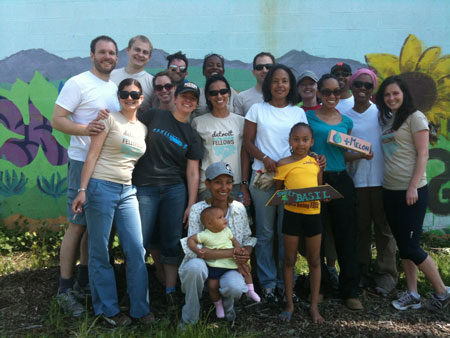
Fellow Matteo Passalacqua works at the Vanguard community development corporation to rehab historic structures as affordable housing in the city's North End, Owiso Makuku joined the governor's Office on Urban and Metropolitan Initiatives, Marcus Clarke at the Detroit Economic Growth Corporation and David Barna at Midtown Detroit Inc. are collaborating to help city firms acquire a larger share of procurement contracts from large local institutions.
One of DRFP's chief goals is that many of the Fellows will make a long-term commitment to help reviving the city, rather than just sampling the Detroit scene on their way to somewhere else. The program was modeled a similar one in New Orleans that brought young talent to the city after Hurricane Katrina-most of whom stayed after the Fellowship ended, according to DRFP Executive Director Robin Boyle, an urban planning professor at Wayne State.
Dan Varner, CEO of Excellent Schools Detroit who hired Fellow Eric Anderson as the organization's Director of Digital Media and Engagement, sees the DRFP as important in reversing Detroit's brain drain. "We've been losing talented folks for a long time. Part of what we have to do to recover our potential is stop that drain. The Fellows program represents that potential."
Jean Redfield, vice-president for Public Programs at Next Energy, a sustainable energy non-profit working with the city, notes, "The program has allowed us to bring in backgrounds we would not ordinarily be hiring. Katy Wyerman fits that with her background in community planning and Erin Kelly with her passion for a waste-free economy. The Detroit Fellows program delivered for us access to skill sets we likely would not have been able to get."

Despite this high level of enthusiasm, director Robin Boyle is frank about the challenges. He admits he did not anticipate the rippling effect the City of Detroit's financial emergency would have on work all across the city. In doing it over again, he would also spend more time helping employers get ready for the Fellows.
Indeed, Boyle may have that chance. Discussions are underway about selecting another round of Fellows to start in the fall of 2013, but no firm decision has been made yet.
"The biggest surprise for me was has been how so many of these people fit in so quickly and incredibly well in the world of Detroit," Boyle notes. "A lot of them are engaged in the community, inside and even outside work. Often I will go to a meeting of some kind or another and walk in to find 2 or 3 Fellows there. That's a very positive sign."
Another positive sign is how many Fellows have become ardent advocates of Detroit as a great place not only to make a difference in the world-but a difference in their own lives and careers. Allyson McLean, who grew up in the Detroit suburbs and has worked on brownfield redevelopment for Pittsburgh's Urban Redevelopment Authority and on strategic planning for the Pentagon and Department of Homeland Security at the D.C.-area consulting firm Booz Allen Hamilton, is now aiding real estate development in low-income communities with the Community Investment Support Fund.
"Now that I am back," she says, "it's frustrating to hear from friends I grew up with who have no plans to ever return. In many cases they aren't necessarily staying in places like Chicago because they've landed great jobs, they simply think it's a cooler place to be. They have no idea what they're missing in their hometown."
Jay Walljasper is author of the Great Neighborhood Book, an associate of the Citistates Group and a Senior Fellow at Project for Public Spaces. He writes regularly about cities for a number of sources including OnTheCommons.org, Shareable.net, and Citiwire.

Maui's Vacation Rental Debate Turns Ugly
Verbal attacks, misinformation campaigns and fistfights plague a high-stakes debate to convert thousands of vacation rentals into long-term housing.

Planetizen Federal Action Tracker
A weekly monitor of how Trump’s orders and actions are impacting planners and planning in America.

In Urban Planning, AI Prompting Could be the New Design Thinking
Creativity has long been key to great urban design. What if we see AI as our new creative partner?

King County Supportive Housing Program Offers Hope for Unhoused Residents
The county is taking a ‘Housing First’ approach that prioritizes getting people into housing, then offering wraparound supportive services.

Researchers Use AI to Get Clearer Picture of US Housing
Analysts are using artificial intelligence to supercharge their research by allowing them to comb through data faster. Though these AI tools can be error prone, they save time and housing researchers are optimistic about the future.

Making Shared Micromobility More Inclusive
Cities and shared mobility system operators can do more to include people with disabilities in planning and operations, per a new report.
Urban Design for Planners 1: Software Tools
This six-course series explores essential urban design concepts using open source software and equips planners with the tools they need to participate fully in the urban design process.
Planning for Universal Design
Learn the tools for implementing Universal Design in planning regulations.
planning NEXT
Appalachian Highlands Housing Partners
Mpact (founded as Rail~Volution)
City of Camden Redevelopment Agency
City of Astoria
City of Portland
City of Laramie


























